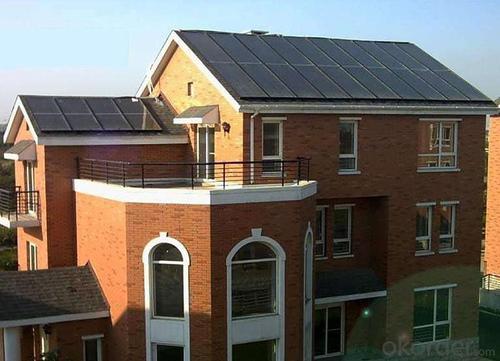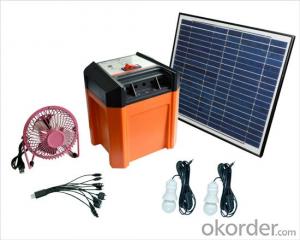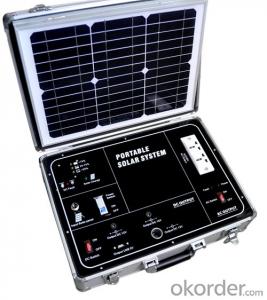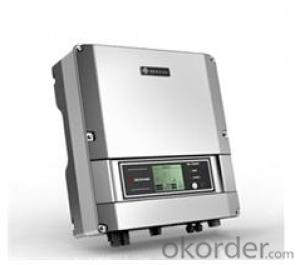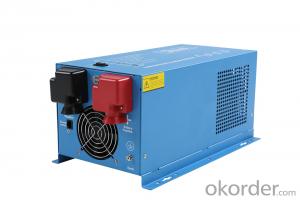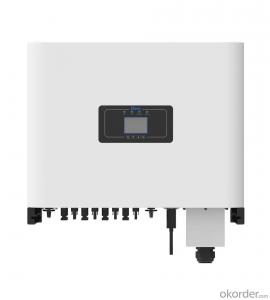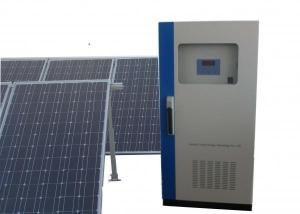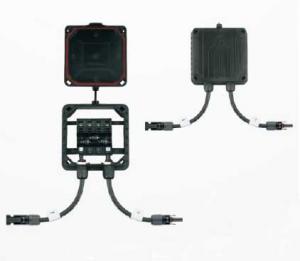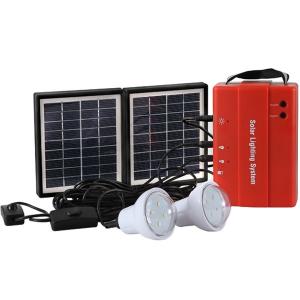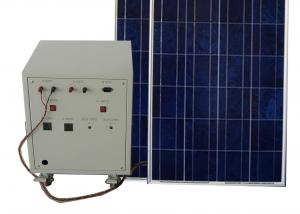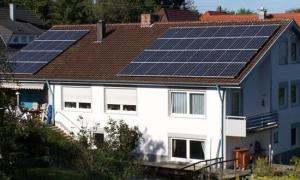Simmark Solar Energy Systems 20kw Solar Grid-Off Power System (3 Phase)
- Loading Port:
- China main port
- Payment Terms:
- TT OR LC
- Min Order Qty:
- 1 set
- Supply Capability:
- 500 set/month
OKorder Service Pledge
OKorder Financial Service
You Might Also Like
Specification
1.Technical parameters of 5kw Solar Off-grid Power System 20KW
- Solar panels
Power(Pmax): 300 Wp
Dimension: 1640x992x40 mm
Working Voltage(Voc): 39.7V
Working Current(Imp):9.32A
Weight: 20 kg
-PV Inverter with controller
Efficiency: >85%
Pure sine wave
AC 380V 50/60Hz output
Working Temp: 0℃~40℃
Battery overvoltage protection,undervoltage protection,overload protection,short circuit protection, overtemperature protection,etc.
650*570*1270mm 180KG
-Mounting Bracket
Flat roof or Ground: Galvanized steel type;
Tile roof: Aluminium type
Wind Load Resistanc: 45m/s
Snow Load: 2kN/m2
-GEL Battery of 12V 250Ah
520*269*228mm 64KG
-DC Cables
PV1-F
TUV/UL certificates
2. Product images
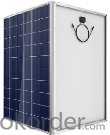
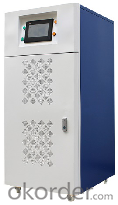
3. Product list
| No. | Item |
| 1 | Solar Panels |
| 2 | PV Inverter with controller built-in |
| 3 | Controller |
| 4 | Mounting racks |
| 5 | DC Cables |
| 6 | AC Cables |
| 7 | MC4 Connectors |
| 8 | GEL Battery |
| 9 | Combiner Box |
| 10 | Distribution box |
4. Remark
-In rainy days, the battery can support 3500W load work 24hours.
-The maximum power load should not exceed 18KW (including inductive load impact: such as refrigerators, air conditioners, washing machines, etc. with motor load).
-The battery can be fully charged in 5-6hours under STC sunshine condition.
5. Package
Wooden case or carton pallet packing


- Q: Can solar energy systems be used in areas with limited access to solar energy system financing options?
- Yes, solar energy systems can still be used in areas with limited access to solar energy system financing options. There are alternative financing options available such as leasing, power purchase agreements, or community solar programs that can help make solar energy systems more affordable and accessible in these areas. Additionally, government incentives, grants, and subsidies can also be utilized to offset the upfront costs of installing solar energy systems in such areas.
- Q: What is the impact of dust storms on solar panels?
- Solar panels can be significantly affected by dust storms. The build-up of dust and debris on the panel surface can block sunlight, resulting in reduced efficiency and electricity generation. Dust particles act as a barrier, preventing sunlight from converting into electricity, leading to decreased power output and overall performance. Moreover, physical damage can also occur during dust storms. The panel surfaces can be scratched or chipped by abrasive particles carried by strong winds, causing long-term degradation and reduced efficiency. Additionally, the accumulation of dust and debris can raise the panel temperature, further decreasing efficiency. To mitigate the impact of dust storms, regular cleaning and maintenance are crucial. Periodic cleaning removes dust and debris, helping to maintain efficiency and maximize electricity generation. Furthermore, installing tilt systems or self-cleaning technologies can effectively prevent or shed off dust accumulation, minimizing the impact of dust storms. In conclusion, dust storms can negatively affect solar panels, reducing efficiency and potentially causing physical damage. However, proper maintenance and cleaning practices can minimize these effects, allowing solar panels to continue generating clean and sustainable energy.
- Q: Are there any risks of electromagnetic interference with solar energy systems?
- Yes, there are potential risks of electromagnetic interference (EMI) with solar energy systems. EMI refers to the disturbance caused by electromagnetic radiation that can disrupt the proper functioning of electronic devices. Solar energy systems, which consist of various electronic components, can be susceptible to EMI from external sources. One common source of EMI is radio frequency interference (RFI) caused by nearby radio or television transmitters, radar systems, or wireless communication devices. These can emit electromagnetic waves that may interfere with the operation of solar energy systems. The interference can result in reduced power output, decreased efficiency, or even complete system failure. Another potential source of EMI is power line interference. Solar energy systems are typically connected to the electrical grid, and fluctuations or disturbances in the grid's electrical signals can introduce interference in the system. This can be caused by nearby power lines, electrical substations, or other electrical equipment. To mitigate the risks of EMI, solar energy systems are designed and installed with measures to minimize interference. This includes using shielded cables, grounding techniques, and adequate spacing between components to reduce the impact of external electromagnetic fields. In addition, solar inverters, which convert the DC power generated by solar panels into AC power, are often equipped with EMI filters to prevent interference from affecting the system's operation. It is important for solar energy system installers and manufacturers to comply with relevant safety standards and regulations to ensure the systems are resistant to EMI. Regular maintenance and inspections can also help identify and address any potential EMI issues. Overall, while the risks of EMI exist for solar energy systems, proper design, installation, and maintenance practices can significantly minimize the impact and ensure the reliable and efficient operation of these systems.
- Q: What is the impact of air pollution on solar panel efficiency?
- Air pollution can significantly reduce the efficiency of solar panels. Particles in the air, such as dust, smog, and industrial emissions, can accumulate on the surface of the panels, blocking sunlight and reducing the amount of energy they can generate. Moreover, certain pollutants like sulfur dioxide and nitrogen oxides can react with sunlight and form a coating on the panels, further decreasing their efficiency. Regular cleaning and maintenance of solar panels are necessary in polluted areas to maintain optimal performance.
- Q: What is the impact of tree shade on the performance of solar panels?
- The impact of tree shade on the performance of solar panels is significant. When solar panels are shaded by trees, it significantly reduces their electricity generation capacity. Tree shade blocks the sunlight that is necessary for the panels to convert into electricity, thus diminishing their efficiency. As a result, shaded solar panels may produce less power or even stop generating electricity altogether. It is crucial to ensure that solar panels are installed in areas with minimal shade to maximize their performance and optimize energy production.
- Q: What are the benefits of using solar energy systems?
- There are several benefits of using solar energy systems. Firstly, solar energy is a renewable and sustainable source of power, meaning it will never run out. Secondly, solar energy is clean and does not produce harmful greenhouse gas emissions, making it environmentally friendly. Additionally, using solar energy can help reduce electricity bills as it allows homeowners and businesses to generate their own electricity. Solar energy systems also require minimal maintenance and have a long lifespan, providing a reliable and cost-effective energy solution. Overall, utilizing solar energy systems contributes to a greener future, cost savings, and energy independence.
- Q: How do solar energy systems affect the installation of satellite dishes?
- Solar energy systems can potentially affect the installation of satellite dishes by obstructing or shading the line of sight between the dish and the satellite. This can result in reduced signal strength or complete loss of signal reception. Proper alignment and placement of both the solar panels and the satellite dish are crucial to ensure minimal interference and optimal performance of both systems.
- Q: What is the difference between a monofacial and bifacial solar panel?
- A monofacial solar panel is a conventional type of solar panel that only uses one side of the panel to capture sunlight and convert it into electricity. Photovoltaic (PV) cells on the single side of the panel absorb sunlight and produce electrical current. Monofacial panels are the most commonly used type of solar panels. On the other hand, a bifacial solar panel is designed to capture sunlight from both sides of the panel. It has PV cells on both the front and back sides, allowing it to generate electricity from sunlight that is reflected or scattered onto the back side. This design has an advantage over monofacial panels as it can generate more energy by harnessing light that would otherwise be wasted. The main difference between monofacial and bifacial solar panels lies in their efficiency and energy output. Bifacial panels can produce more electricity per unit area than monofacial panels because they can capture light from both sides. This makes bifacial panels a suitable choice for situations where space is limited and maximizing energy production is crucial. Additionally, bifacial panels can benefit from certain installation configurations that allow light to bounce off the ground or other nearby surfaces onto the backside of the panel, further increasing their energy output. This makes them particularly effective in environments with high levels of ground reflectance, such as snow-covered areas or locations with white rooftops. However, it is important to note that the increased efficiency and energy output of bifacial panels come at a higher cost compared to monofacial panels. Bifacial panels require more complex design and manufacturing processes, which contribute to their higher price. Additionally, the installation of bifacial panels may require specialized mounting systems to ensure proper exposure to both sides of the panel. To summarize, the main difference between monofacial and bifacial solar panels is their ability to capture sunlight. Monofacial panels use only one side of the panel to generate electricity, while bifacial panels utilize both sides, resulting in higher efficiency and energy output. However, the higher cost and specific installation requirements make bifacial panels a more specialized choice compared to the widely used monofacial panels.
- Q: What is the role of voltage optimizers in a solar energy system?
- The role of voltage optimizers in a solar energy system is to optimize and regulate the voltage levels of the electricity produced by the solar panels. Solar panels generate direct current (DC) electricity, which needs to be converted to alternating current (AC) in order to be used by most household appliances and to be fed into the electrical grid. However, the voltage produced by solar panels can vary depending on various factors such as sunlight intensity, temperature, and shading. This inconsistency in voltage can lead to inefficient energy production and can potentially damage the electrical equipment connected to the system. Voltage optimizers help address these issues by stabilizing and regulating the voltage levels within the solar energy system. They ensure that the voltage produced by the solar panels is consistent and within the optimal range for efficient energy production. By maintaining a stable voltage, voltage optimizers also protect the electrical equipment from potential damage caused by voltage fluctuations. Furthermore, voltage optimizers can improve the overall performance and efficiency of the solar energy system. By optimizing the voltage levels, they reduce energy losses and maximize the electricity output of the solar panels. This improves the overall system efficiency and helps to maximize the return on investment for the solar energy system. In summary, voltage optimizers play a crucial role in a solar energy system by stabilizing and regulating the voltage levels, ensuring efficient energy production, protecting electrical equipment, and maximizing the system's overall performance and efficiency.
- Q: How does the efficiency of solar panels vary between manufacturers?
- The efficiency of solar panels can vary between manufacturers due to differences in the materials used, manufacturing processes, and overall design. Some manufacturers may use higher-quality materials and advanced technologies, resulting in more efficient panels that can convert a higher percentage of sunlight into electricity. Additionally, variations in the size, shape, and arrangement of solar cells can also impact efficiency. Therefore, it is important to consider the reputation, research, and testing conducted by different manufacturers when comparing the efficiency of solar panels.
Send your message to us
Simmark Solar Energy Systems 20kw Solar Grid-Off Power System (3 Phase)
- Loading Port:
- China main port
- Payment Terms:
- TT OR LC
- Min Order Qty:
- 1 set
- Supply Capability:
- 500 set/month
OKorder Service Pledge
OKorder Financial Service
Similar products
Hot products
Hot Searches
Related keywords


